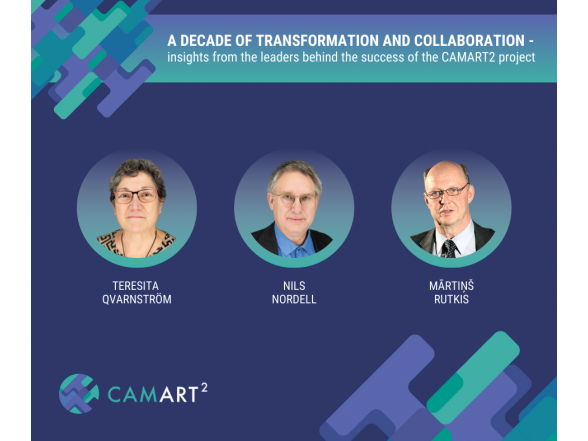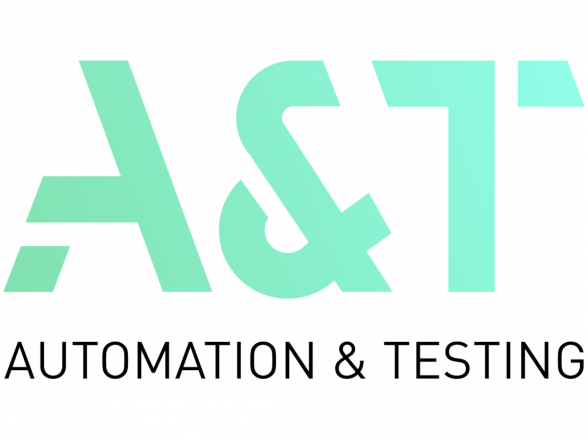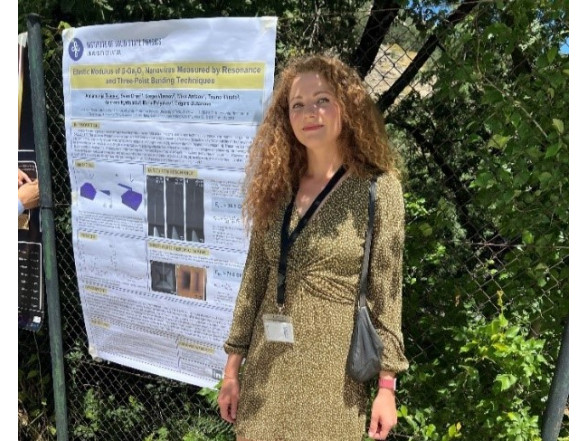In September 2024, we celebrated a decade since the CAMART2 project application was submitted by a dynamic partnership: the Institute of Solid State Physics, University of Latvia (ISSP UL), KTH Royal Institute of Technology (KTH), and RISE Research Institutes of Sweden. This collaboration, which has roots extending even before CAMART2, has made a profound impact not only on the involved organizations but on almost everyone in them. To reflect on the genesis of the CAMART2 project and its significance for all partners involved, we sat down with the key figures who have been integral since the beginning: project coordinator and former Deputy Director for Science and later Director of ISSP UL, Dr. Mārtiņš Rutkis; now retired former Director of KTH’s Electrum Laboratory, Dr. Nils Nordell; and Senior Scientist, Project Leader, and Business Developer at RISE, Dr. Teresita Qvarnström. Join us as we look at the remarkable journey of the CAMART2 project through the eyes of the people who were involved in its implementation from the very beginning.
What inspired the initiation of the CAMART2 project? Who started it?
Mārtiņš: It was me. When I started as Deputy Director for Science in 2012, it was obvious that the ISSP UL needed institutional change, as the Institute’s departments were largely on their own, lacking the collaboration necessary for development. There were already some infrastructure projects with European Union participation, but these were confined to individual laboratories. There was not enough money for structural change. Then, the first Widening Call came along. After reading the conditions, I realized that this was exactly what the ISSP UL needed: Open Access laboratories, with open access to facilities both internally and externally, and collaboration with industry.
We had already collaborated with CAMART2 partners on a smaller scale in the TechNetNano project, where the University of Latvia was the main collaborator from Latvia. We had active contacts with Nils but less with Teresita. Since the KTH Electrum Laboratory, represented by Nils, had a lot of experience in Open Access and industry collaboration, it made sense to approach him. It was the second issue (collaboration with industry) that prompted Nils to approach RISE (then ACREO) as a second collaborator.
Nils: In May 2014, I received a thoughtful letter from the ISSP UL, which included an invitation to discuss a potential Teaming project. I realized this project could have a broader scope, extending beyond KTH and the Electrum lab, so I invited Teresita and RISE to contribute to the innovation aspect of the project.
Teresita: RISE and KTH worked for decades in a strong ecosystem for research and innovation around Electrum Laboratory. We had a successful environment with a high impact on the development of new technologies, technology transfer, and the creation of new enterprises, and we aimed to share our experiences with ISSP UL.
What objectives did you aim to achieve for each of your organizations?
Nils: For KTH, sharing our experiences in technology transfer and infrastructure was very important. I wanted to demonstrate how to blend research and industry through innovation, motivating others to adopt similar approaches. ISSP UL had significant potential, including a cleanroom that, although not well-equipped at the time, provided a foundation for building robust infrastructure. I hoped that engaging in the CAMART2 project would attract industrial partners to the Electrum lab. While we didn’t gain many customers through this project, we achieved numerous other positive outcomes. My aim was to increase the number of users at the Electrum lab.
Teresita: Sharing experiences related to technology transfer and the innovation climate in Kista, Stockholm, was vital. Networking and collaborating with peers who have similar infrastructures were key goals. CAMART2 provided an excellent platform for us to focus on our motivations and analyze our processes, leading to valuable insights. This project significantly raised our profile in Europe; I began receiving inquiries from other organizations about innovation issues thanks to our enhanced visibility. CAMART2 was not only a well-conceived project but also one of the first of its kind, with many in Europe striving for similar projects.
Mārtiņš: The main objectives for ISSP UL were Open Access, collaboration with industry, innovation, and staff development.
We wanted, firstly, to change the internal culture, which included mutual collaboration and access to infrastructure for all ISSP UL scientists; secondly, to develop collaboration with industry, facilitating innovation. There was a desire to expand the Institute’s activities from a strongly academic to an application- and innovation-oriented one. These objectives also included introducing intellectual property management and a quality system to facilitate collaboration with industry.
The project also aimed to develop staff, attract the next generation of scientists, and build international networks. Attracting young professionals has also led to the need to develop new study courses at the Faculty of Physics, Mathematics, and Optometry, University of Latvia, including expanding the study program by adding application-oriented courses.
How did you view ISSP UL before CAMART2? Did you see its potential?
Teresita: My first visit to the institute revealed an underutilized cleanroom. Our mission in the CAMART2 project was to exemplify best practices and demonstrate effective methodologies. Our goal was to strengthen partnerships around the Baltic Sea. Initially, I was uncertain about the overlap in our research focus—ISSP UL concentrated on basic research, while RISE focused on applied physics. However, we soon began to learn from each other and focused on sharing experiences to help advance ISSP UL.
Nils: During my first visit to ISSP UL, I met highly capable researchers with an evident need for modern tools. I recognized substantial potential; a European project of this scale could impact numerous individuals and provide essential resources for laboratories.
Can you describe the challenges encountered during the implementation of the project?
Nils: Collaboration can be challenging, as it often hinges on individual personalities. Throughout the project, we enjoyed strong collaboration within the management team, learning from one another and engaging in meaningful discussions. The real challenge has been to extend this collaborative spirit throughout the organization, encouraging team members to forge partnerships for long-term research collaboration. Now, after several years, we are finally collaborating effectively, conducting joint research and co-authoring papers. It has been a lengthy journey, but we are now seeing the fruits of our efforts.
Teresita: In the initial years of the CAMART2 project, RISE’s role was to collaborate with leaders to establish the innovation department, foster industry relationships, and drive cultural changes within the organization. This involved a lot of coaching. Initially, our application lacked a focus on research collaboration. Over time, we recognized that cultivating a collaborative culture was crucial for the project’s sustainability. We needed to engage researchers in each organization, which led us to prioritize what we now refer to as "scientist-to-scientist" collaborations. For RISE, it has only been in the last two years that we’ve dedicated significant resources to promote these collaborations. We now have 18 team members focused on these efforts, and the maturity of ISSP UL has greatly improved compared to the project’s outset. Our colleagues are now eager to collaborate with ISSP UL because they recognize the valuable expertise that is available. We are actively pursuing six different lines of research collaboration, all of which are gaining momentum. Many of these areas are new, combining competencies in systems-level research with material science from ISSP UL. It’s been incredibly rewarding, and there’s been a lot of buzz around CAMART2 recently.
Moving forward, I believe these research lines will continue to thrive as researchers connect and benefit from one another. The initial challenge of getting things underway was significant, but the project’s duration has been advantageous. Building relationships and fostering collaboration takes time, and achieving meaningful results cannot happen overnight.
Mārtiņš: For my part, I don’t recall major obstacles to the implementation of the project at the ISSP UL. It is quite paradoxical that we were able to predict what we would achieve and what the performance indicators would be when we were preparing the CAMART2 application. There are two exceptions: the number of publications and innovation. Even though the number of publications is smaller than intended, their quality constantly increases. Researchers have the ambition to publish their work in high-quality journals to make a serious impression on the global scientific community. The other thing is that initially, we were too optimistic about the budget revenue from innovation. We overestimated the opportunities that the industry can provide. I think this is an objective situation because we cannot change the whole market by creating a few companies.
How has the collaboration among the consortium partners evolved, and what key achievements or milestones are you particularly proud of in the project’s progress from initiation to completion?
Nils: I am pleased with the scientist-to-scientist engagement we’ve fostered. I’ve advocated for developing "demonstrators" together—small scientific steps involving ISSP UL and KTH researchers, which could serve as the foundation for future research applications, joint publications, or even spin-offs. While we haven’t fully realized this yet, I believe that collaboratively addressing a concrete technological problem, leveraging the competencies and resources of both organizations, has been a significant advancement for the project and will enhance the sustainability of our collaboration beyond CAMART2.
Mārtiņš: I agree that the scientist-to-scientist collaboration has been crucial for ensuring the sustainability and continuation of our partnership after CAMART2 concludes. From my perspective, the project has unfolded in three major phases. The first phase involved administrative and organizational changes, during which we adopted best practices from our partners. This phase lasted about two to two and a half years and greatly improved our institutional organization and operations.
The second phase focused on scientific collaboration, which presented its own challenges. Unlike other teaming activities, our project was primarily centered on institutional development rather than scientific collaboration. We recognized the importance of fostering scientific partnerships and dedicated significant effort to this. This phase was vital for advancing the maturity of science at ISSP UL and establishing a foundation for future collaboration.
Currently, we are in the third phase, where the scientist-to-scientist collaborations initiated earlier are now self-sustaining. As we look ahead beyond CAMART2, I believe these collaborations are crucial. Additionally, I want to emphasize how much we learned from the first phase, particularly from KTH and the Electrum lab, which has a long history of success. We have been able to adopt these best practices, learning not from our failures but from their successes. The same applies to RISE, particularly regarding innovation policy and industry engagement, which have helped us develop our innovation system at ISSP. The first phase significantly benefited ISSP UL as an institution, while the second phase was essential for ensuring ongoing collaboration. I see that we have planted good seeds, which will likely continue to flourish, as we have already seen in some instances.
Teresita: Over time, the number of researchers in our organization interested in collaborating with ISSP UL has increased significantly. We now have strong momentum to pursue funding for future collaborations. Throughout the project, my role has focused on establishing an organizational framework for connecting research with technology transfer and innovation. It has been vital for this collaboration to be sustainable, as our organizations, especially mine, have demonstrated that systems are not static; they are constantly evolving. We must find ways to communicate to encourage our researchers to continue developing science together. They are eager to collaborate in exciting and novel areas that benefit both us and ISSP UL, ensuring that our work extends beyond the conclusion of CAMART2, which is a notable success.
Although we may not be working in the same areas, scientific challenges are evolving, particularly with intelligent systems for sensing and analysis. This is why we have combined our competencies, even though we are at different points in the value chain. Over the past few years, this collaboration has led us to discover truly interesting projects to work on together.
Nils: Exactly. It has been a challenge to identify areas where we can complement each other and collaboratively build on our diverse experiences and research domains.
Mārtiņš: I would also like to point out that while it may seem straightforward to identify these areas, collaboration focused on institutional development may not be a long-term priority. However, scientific collaboration certainly is, and I’m very glad we have invested considerable effort into this during the recent years of CAMART2. As you recall, the previous project, TechNetNano, was primarily focused on organizational issues. When it concluded, active collaboration diminished significantly. While some scientific collaboration persisted among certain groups, it wasn’t widespread. I hope we can avoid a similar situation after CAMART2, as we have been proactive in developing our scientist-to-scientist activities. The initial phase of organizational change, achieved with the help of our partners KTH and RISE, is crucial for the development of ISSP UL, while the second phase I mentioned before is more vital for fostering collaboration.
Looking back, what lessons have been learned from the CAMART² project implementation?
Teresita: One of the key lessons learned is the importance of organizational and cultural change. While all the efforts made were significant, they would have been meaningless without the active involvement of our scientific staff. Over the past three years, we managed to engage them effectively, which was a notable achievement because, initially, there was nothing about scientific collaboration in the project. We had to adjust our goals to gain the European Commission’s acceptance, and it became clear that this was a worthwhile endeavor. Seeing interest in using each other’s infrastructure and collaborating on exciting projects, like exploring entangled electrons, is gratifying.
Nils: A crucial takeaway from this project is the need to create opportunities for smaller research initiatives to be funded alongside larger projects. Fifteen million euros is a substantial amount, and if it solely goes towards administrative and organizational development, it feels excessive in this context. It would be much more effective if the funds could also support research activities, minor projects, or even small start-up endeavors. Additionally, I learned the importance of the project’s duration. Having worked together for over a decade has solidified a strong foundation for future collaboration. A lengthy project allows for meaningful relationships to develop, ensuring that we don’t leave everything behind when the project ends.
Teresita: If we had included scientific collaboration in our initial application years ago, we might have misidentified our areas of expertise. Innovation, reorganization, and cultural change take time, and during that period, scientific interests and research areas evolved—some didn’t even exist at the start of our collaboration.
Nils: Keeping an open approach when drafting the application is essential. It would be best if you didn’t have to specify exact collaboration outcomes or research results from the outset. This is something the European Commission should consider when formulating their calls. They should discuss collaboration in general terms rather than pinpoint specific research goals.
Mārtiņš: Reflecting on the proposal writing process, we closely scrutinized the call, which clearly stated that the project would not support scientific endeavors. However, albeit indirectly, we recognized the necessity of incorporating some scientific elements. We’ve managed to allocate CAMART² funds towards science, and we hope all our expenses will be approved at the project’s conclusion since we diligently adhere to the rules. Nonetheless, this is a limitation of such a large project. I concur with Nils that 15 million euros is excessive for just organizational change within one institution. The potential benefits for our advanced partners were diminished because, while KTH and RISE provided valuable consultations to ISSP UL, the reciprocal organizational change was limited.
Do you have any recommendations for the future of ISSP UL?
Nils and Teresita: We envision a bright future for ISSP UL.
Nils: Having journeyed with ISSP UL for over a decade, I can confidently say the progress has been remarkable. ISSP UL should continue on this path, further developing its organization, infrastructure, scientific goals, and innovation while consistently setting new objectives. This approach will ensure that ISSP UL remains a vital part of the European research and innovation community.
Mārtiņš: Thank you for your optimistic outlook on ISSP UL! Everyone is committed to making this future even brighter. It’s crucial to note that the generation that initiated the CAMART² project ten years ago is either retiring or nearing retirement. Therefore, it is essential that we have nurtured successors who will carry on our work in the coming decade. For them, maintaining and building upon our achievements is vital. CAMART² has provided a solid foundation, and as the project concludes, we require new momentum to propel us forward. I hope the next generation will successfully manage this transition—that’s the most critical aspect.
The CAMART2 project has paved the way for future collaborations. The collective efforts of the ISSP UL, KTH, and RISE have demonstrated the power of international partnerships in advancing scientific and technological frontiers.
We extend our heartfelt gratitude to Dr. Mārtiņš Rutkis, Dr. Nils Nordell, and Dr. Teresita Qvarnström for sharing their valuable insights and experiences. Their dedication and vision have been instrumental in the success of CAMART2, and their stories will undoubtedly inspire future generations of researchers and collaborators.
About CAMART2 project
The CAMART² project aimed to upgrade the existing Centre of Excellence in Advanced Material Research and Technology at the Institute of Solid State Physics, University of Latvia (ISSP UL) to a new and significantly stronger center. It focuses on increasing research commercialization, enhancing collaboration between academia and businesses, and developing a platform for joint research and technology transfer. The project helps boost innovation, economic growth, and competitiveness in the Baltic Sea region by bridging the gap between research and industry. The CAMART² project is based on a long-term partnership between ISSP UL, KTH Royal Institute of Technology – the largest technical university in Sweden, and RISE – Research Institutes of Sweden.



